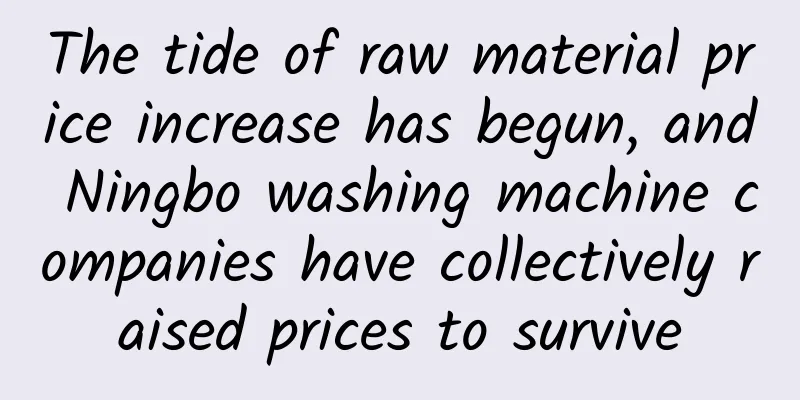Don't panic during the rainy season! Test 8 popular dehumidifiers to tell you which one is better

|
If you ask southerners what season they fear the most, apart from the magical attacks in winter, it would probably be the rainy season of plum rains. Once it rains, it can last for half a month. Clothes won’t dry even after washing and the room is wet. It is really uncomfortable. Before the arrival of the plum rain season this year, we have specially arranged a review of dehumidifiers priced under 1,000 yuan for you, hoping to save you who are trapped in the plum rain season and the return of the south wind. We have selected 8 brands that are highly popular, with prices ranging from just over 200 yuan to nearly 700 yuan. 1. Dehumidification effect For friends living in the south, instead of using the dehumidification function of the air conditioner, they decide to buy a dehumidifier for a better dehumidification experience. However, the descriptions of the dehumidification effect on the details page of each dehumidifier are completely different: dehumidification capacity, high temperature dehumidification capacity, nominal dehumidification capacity, maximum dehumidification capacity... We are often puzzled when seeing this. Among these indicators with different names and units, which one represents the best dehumidification effect? According to the main technical parameter requirements of the national standard "Dehumidifier" GB/T 19411-2003, it is not difficult to see that the nominal dehumidification capacity should be marked on the product label. The national standard also defines the nominal dehumidification capacity: it refers to the nominal value of the condensation water when the dehumidifier runs for 1 hour under the nominal working conditions of temperature 27°C and relative humidity 60%. We sent 8 dehumidifiers to the laboratory and tested their nominal dehumidification capacity according to the national standard method. The result very realistically proves the saying: you get what you pay for. Among the samples evaluated this time, the dehumidifiers priced below 500 yuan have a nominal dehumidification capacity between 0.0061 and 0.0162 kg/h; while the dehumidifiers priced between 500 and 1,000 yuan can reach 0.223 to 0.314 kg/h, which means that in a constant temperature and humidity test chamber at 27°C and 60%RH, the dehumidifier can remove an average of 0.223 to 0.314 kg of moisture from the air per hour. After seeing the test results, have you ever thought about why the indicators used in these sample details are so diverse? Under the same "standard", the actual dehumidification effect is clear at a glance. In order to better package products, brands naturally cannot present the "reality" so nakedly to consumers. Take daily dehumidification and high temperature dehumidification as examples. Many of them are measured based on 30℃ and 80%RH humidity. But in real life, when the room temperature reaches 30 degrees, we usually turn on the air conditioner to cool down, and we don’t use the dehumidifier at this time. Therefore, the test results in this case are basically meaningless to ordinary consumers, but for brands, they can become more eye-catching numbers in publicity and details. 2. Differences in effects and reasons From the chart of nominal dehumidification capacity of samples, we can see that the values of the lowest and highest two samples differ by 51 times, so what are their actual dehumidification effects? We randomly selected a sample from each of the two teams and tested it in the Dad's experimental cabin (12m²): the initial humidity of the experimental cabin was about 85%. As the dehumidifier was turned on, the humidity in the room became lower and lower. At this time, we recorded the humidity change process. The results are obvious. After the No. 5 dehumidifier was turned on, the indoor humidity dropped very quickly. In half an hour, the unbearable humid indoor environment (humidity 85%) became a relatively comfortable environment (humidity 50-60%). After it was turned on for 2 hours, the indoor humidity dropped to about 30% (drying mode turned on), which was already very dry. However, after 2 hours with the No. 3 dehumidifier, the indoor humidity was still above 75%. Among these, the price difference may determine the differences in the internal structure and materials of the dehumidifier. Therefore, we disassembled all the machines and found that dehumidifiers priced below 500 yuan use semiconductor refrigeration technology; while more expensive machines all use compressor refrigeration, like the refrigerators and air conditioners used in homes, which also use compressor refrigeration, with good cooling effect and low energy consumption. Many people may be too familiar with semiconductor refrigeration. It uses special semiconductor materials to form a PN junction to produce the Peltier effect. To put it simply, "after electricity is turned on, one end of the semiconductor material becomes cold and the other end becomes hot." We tested and found that the surface temperature of the semiconductor refrigeration condenser can reach as low as around 0℃. The lower the surface temperature, the more conducive it is to the condensation of moisture in the air. This is just like when the ambient temperature is lowest at night or in the early morning, many dew drops will condense on the leaves. But even so, the heat exchange surface area of its condenser is still too small. We roughly estimated that the heat exchange surface area is only 5.6 dm² (taking dehumidifier No. 3 as an example). Compared with the cooling fins of the compressor, the heat exchange surface area can reach about 135 dm² (taking dehumidifier No. 5 as an example), and the air duct design is more reasonable and the condensation effect is better. 3. Noise and Power In addition, we also tested the noise and power of 8 dehumidifier samples in the laboratory. The noise of the dehumidifier mainly comes from the fan inside. Although the compressor can produce certain noise when running, the actual sound is still relatively light. According to the laboratory test results, it is not difficult to find that the noise levels of the two types of dehumidifiers, compressor and semiconductor, are different, and there is no obvious difference. As for power consumption, compressor-cooled dehumidifiers use higher power during operation, which is 2 to 3 times that of semiconductor refrigeration, and is not much different from the power of a household 30-inch or 40-inch LCD TV. But this does not mean that compressor cooling consumes electricity. Generally speaking, if the indoor humidity drops to 50%~60% RH (the default settings are different for different models), the compressor will stop running to balance comfort and power saving. At this time, the overall power of the machine will drop to 20W, or even around 1w, which is very energy-saving. Therefore, the key to whether a dehumidifier consumes electricity is its dehumidification efficiency, that is, the amount of dehumidification per kilowatt-hour of electricity consumed. Now, everyone knows why the refrigerators, air conditioners, etc. in our homes all use compressors for refrigeration, right? 4. Negative ions When we were studying the sample detail pages, we found that 4 dehumidifiers claimed to have the "negative ion purification" function, allowing consumers to breathe healthy and fresh air. Well, we are very curious, where do these negative ions come from? It just so happened that the two dehumidifier samples we disassembled both claimed this function, so our review researcher proceeded to dismantle them... Oh no, disassemble them! After some operations, we finally found this "little cutie" in the fuselage - the negative ion generator. After seeing this thing, you should have an idea of its effect... If you are not discouraged, let us show you its price... We found the negative ion generator's factory on 1688 based on the merchant information on it. Yes, you read that right, it only costs 4... bucks... Its principle is even simpler: the high-voltage electrode discharges and produces negative ions. When the particles come into contact with the negative ions, they become charged and aggregate into large particles, which then settle or adsorb on the surface of the object. Even if we take a step back, even if it is really useful, the settled particles may be blown up again and cause secondary pollution. We still need to be cautious about the negative ion purification function claimed by dehumidifiers. Because for merchants, by spending an extra 4 yuan, they can create an extra selling point for their products. Why not do it? Finally, we have also summarized some recommendations for purchasing a dehumidifier. We hope that everyone can spend this rainy season in a dry and cool place! References: [1] Zheng Yongming, Fang Fang, Xu Jianyi, et al. Research on the principle of semiconductor refrigeration and its application system design [J]. China Testing, 2006, 32(2):49-51. [2] Zhang Anshu. Chemical process of semiconductor dehumidifier [J]. Journal of Fuzhou University: Natural Science Edition, 1992(03):107-111. |
>>: Barnacles are never seen on killer whales. Do barnacles bully the weak and fear the strong?
Recommend
Over the past 2000 years, these thrilling volcanic eruptions have had a huge impact on the global climate!
Volcanic eruptions have important climate effects...
This is the first time I have seen such a comprehensive information flow optimization case!
After reading this article, you will be able to i...
So content marketing can be done this way?
Nowadays, content marketing is regarded as a trea...
How to continuously obtain seed users?
There are many techniques for acquiring seed user...
Seven tips to teach you how to play with self-media!
In recent years, as the earlier batches of person...
Many places have entered the heating season! Be sure to pay attention to these things, otherwise you will get sick!
Starting from November 1st, Shenyang, Tianjin and...
Li Xiang: Tesla has already hit our doorstep, let’s stop making self-congratulatory propaganda about the 60-speed constant speed.
Today, Tesla launched the basic version of Model ...
How to make a mini program for Lanzhou clothing store? How to build a clothing WeChat applet?
The Internet has undergone a development trend in...
Efficient strategy to recall lost APP users!
Before starting today's topic, let's talk...
How much does it cost to customize the Zaozhuang coupon mini program? Zaozhuang coupon applet customized price inquiry
How much does it cost to customize the Zaozhuang ...
Simple brick-moving project: PPT extension project, how can it help you make money without doing anything?
Many friends think that interest is the basis of ...
Can Fengxing TV, which has gathered five pearls, really sell tens of millions of units in three years?
Before we officially talk about the next protagon...
Often stay up late, and your ears suddenly become deaf? If you have these bad habits, change them quickly
As the saying goes If you don't work hard tod...
Today in Science and Technology History | 1997·9·25 Chinese scholars solved the mystery of "Shangri-La"
In 1933, British writer James Hilton described in...
A review of the top 10 Douyin e-commerce cases of the year!
Douyin e-commerce in 2021 is like the American We...




![A Complete List of Professional Terms in the Mobile Internet Industry [2016 Latest Edition]](/upload/images/67cc3e3d61195.webp)




